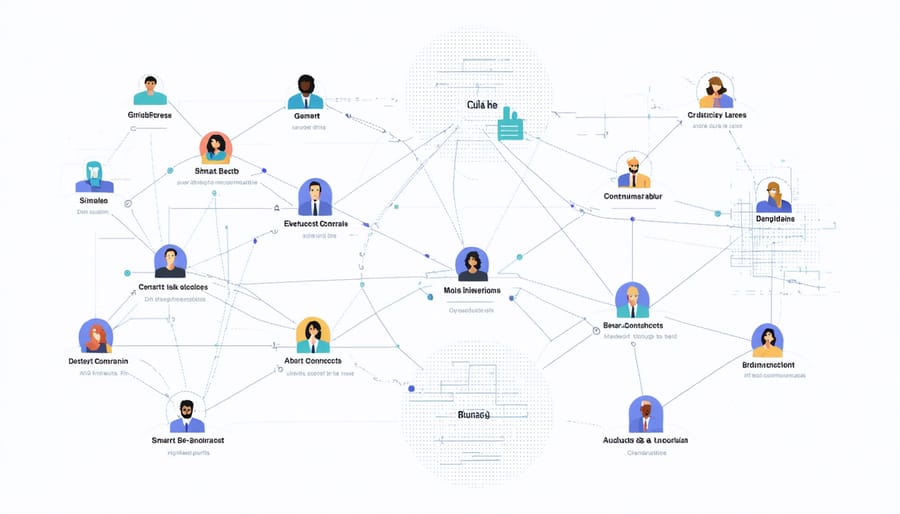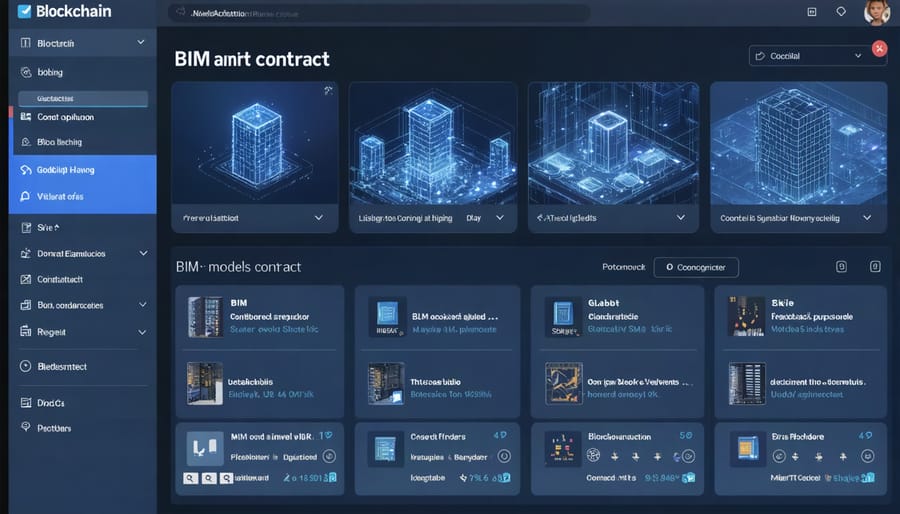Revolutionizing construction project delivery, blockchain technology in construction represents a paradigm shift in how industry professionals manage, verify, and secure their operations. This distributed ledger technology transforms traditional construction processes by creating an immutable record of transactions, contracts, and supply chain operations—all accessible in real-time by authorized stakeholders.
Unlike conventional database systems, blockchain applications in construction establish a transparent, decentralized network where every transaction and document modification is permanently recorded and verified by multiple parties. This technological advancement addresses critical industry challenges, from payment disputes and contract compliance to material tracking and quality assurance.
For construction executives and project managers evaluating digital transformation strategies, blockchain applications offer a compelling solution to streamline operations, reduce disputes, and enhance project transparency. By implementing smart contracts and automated verification processes, these applications can significantly reduce administrative overhead while increasing trust among project stakeholders.
This comprehensive guide explores how blockchain applications are reshaping the construction landscape, offering practical insights for implementation and real-world examples of successful adoption across various project types and scales.
What Makes a Construction Blockchain Application Different?
Core Components of Construction Blockchain Solutions
Blockchain solutions in construction are built upon three fundamental components that work together to ensure transparency, security, and efficiency. Smart contracts serve as self-executing agreements that automatically enforce project terms, manage payments, and trigger actions based on predetermined conditions. These digital contracts are particularly valuable in managing complex construction workflows, from material procurement to subcontractor payments.
The distributed ledger technology (DLT) forms the backbone of construction blockchain applications, maintaining an immutable record of all project transactions, documents, and changes. This shared database is continuously synchronized across multiple nodes, ensuring that all stakeholders have access to the same verified information in real-time. The decentralized nature of DLT eliminates single points of failure and reduces the risk of data manipulation.
Consensus mechanisms ensure the validity of all transactions and changes within the blockchain network. In construction applications, these mechanisms typically employ Proof of Authority (PoA) or Practical Byzantine Fault Tolerance (PBFT) protocols, which are more suitable for enterprise environments than traditional Proof of Work systems. These protocols validate transactions through pre-approved network participants, maintaining efficiency while ensuring data integrity across the project lifecycle.
Together, these components create a robust framework for managing construction projects with enhanced accountability and reduced administrative overhead.

Integration with Existing Construction Systems
Blockchain applications in construction are designed to seamlessly integrate with existing digital infrastructure, particularly through BIM integration and project management platforms. This interoperability enables real-time data synchronization across multiple systems, creating a unified digital ecosystem for construction projects.
Modern blockchain solutions interface with BIM models to create immutable records of design changes, ensuring version control and accountability throughout the project lifecycle. When connected to project management software like Procore or Autodesk Construction Cloud, blockchain applications can automatically validate and record key project milestones, material deliveries, and quality inspections.
Integration protocols typically utilize API frameworks and standardized data formats to ensure smooth communication between systems. This allows for automated smart contract execution based on predefined triggers from IoT sensors, digital twins, or other connected construction technologies. The result is a transparent, verifiable record of all project activities that can be accessed by authorized stakeholders while maintaining data security and integrity across the entire construction technology stack.
Key Applications in Modern Construction
Supply Chain Management and Material Tracking
In construction, blockchain technology revolutionizes supply chain management by creating an immutable digital ledger that tracks materials from source to installation. This transparency enables all stakeholders to verify the authenticity and journey of construction materials, significantly reducing the risk of counterfeit products and ensuring quality compliance.
The system works by assigning unique digital identifiers to materials and components, recording each transaction and movement through smart contracts. When materials arrive on-site, their digital signatures are automatically verified against the blockchain record, confirming their origin, specifications, and handling conditions throughout transit.
For example, in steel procurement, blockchain tracking allows project managers to verify the steel’s grade, manufacturing date, testing certificates, and transportation conditions. This level of traceability helps ensure structural integrity and compliance with building codes while streamlining the inspection process.
Real-time material tracking through blockchain also enhances inventory management and delivery scheduling. Project managers can monitor material locations, anticipate delays, and adjust construction schedules accordingly. This visibility helps prevent work stoppages due to material shortages and reduces excess inventory costs.
Additionally, blockchain’s distributed nature ensures that all supply chain participants – from manufacturers to contractors – have access to the same verified information, eliminating disputes about material quality or delivery timing. This shared truth source strengthens accountability and facilitates faster issue resolution when problems arise.

Smart Contracts for Project Execution
Smart contracts represent a revolutionary advancement in project execution, automating crucial processes within construction projects through blockchain technology. These self-executing contracts contain predefined rules and conditions that automatically trigger actions when specific criteria are met, eliminating the need for intermediaries and reducing administrative overhead.
In construction projects, smart contracts streamline payment processes by automatically releasing funds when predetermined milestones are achieved and verified. For instance, when a building’s foundation is completed and inspected, the smart contract can automatically trigger payment to the subcontractor, ensuring timely compensation and reducing payment disputes.
These digital agreements also enhance transparency and accountability in supply chain management. When materials arrive on-site and are verified through IoT sensors or authorized personnel, smart contracts can automatically update inventory systems and initiate payment to suppliers. This automation reduces paperwork, minimizes human error, and creates an immutable record of all transactions.
Project managers can leverage smart contracts to enforce compliance with project specifications and timelines. The contract can automatically flag deviations from agreed-upon standards or delays in milestone completion, enabling quick corrective action. Additionally, smart contracts can manage complex multi-party agreements, ensuring all stakeholders meet their obligations while maintaining a transparent audit trail.
The integration of smart contracts with Building Information Modeling (BIM) systems creates a powerful tool for project coordination, automatically updating project status and managing document workflows based on real-time construction progress.
Quality Assurance and Compliance
Blockchain technology offers unprecedented opportunities for quality assurance and compliance verification in construction projects. By creating an immutable digital record of inspections, material certifications, and compliance documentation, blockchain ensures transparency and accountability throughout the construction lifecycle. This integration with data analysis in construction enables real-time verification of building standards and regulatory requirements.
Smart contracts automatically validate that materials meet specified quality standards before they’re accepted on-site, while IoT sensors can feed real-time data into the blockchain for continuous monitoring of construction conditions. This creates a tamper-proof audit trail that helps prevent the use of substandard materials and ensures adherence to building codes.
The technology also streamlines the certification process by enabling instant verification of contractor qualifications, material specifications, and safety compliance. Each stakeholder can access and verify documentation instantly, reducing delays and potential disputes. For instance, when a concrete supplier delivers materials, their quality certificates are automatically verified against project requirements and permanently recorded on the blockchain.
This systematic approach to quality assurance reduces the risk of costly rework, enhances project transparency, and provides undisputable evidence of compliance with construction standards. It also simplifies regulatory inspections by providing authorities with comprehensive, chronological records of all quality-related activities and certifications.
Implementation Considerations
Technical Requirements and Infrastructure
Implementing a blockchain application in construction requires robust digital security infrastructure and specific technical components. At minimum, organizations need a distributed network of nodes, each requiring high-performance servers with substantial processing power and storage capacity. These nodes maintain synchronized copies of the blockchain and validate transactions.
Essential hardware requirements include dedicated servers with multi-core processors, minimum 16GB RAM, and scalable storage solutions starting at 1TB. The network must maintain high-speed internet connectivity with redundant connections to ensure uninterrupted operations.
On the software side, organizations must implement:
– Blockchain platform software (such as Hyperledger Fabric or Ethereum Enterprise)
– Smart contract development environment
– Database management systems
– API integration tools
– Security protocols and encryption systems
Cloud infrastructure can provide scalability and reduce initial setup costs, with major providers offering blockchain-as-a-service solutions. However, construction companies should consider hybrid solutions that maintain critical data on-premises while leveraging cloud benefits.
Regular system maintenance, security updates, and technical support are crucial for sustainable operations. Organizations should also establish backup systems and disaster recovery protocols to protect against data loss or system failures.
Training and Change Management
Implementing blockchain technology in construction organizations requires a comprehensive training and change management strategy. Success depends on preparing teams at all levels, from field workers to executive management, for the transition to blockchain-based systems.
The first step involves conducting a skills assessment to identify knowledge gaps across the organization. This assessment helps develop targeted training programs that address specific needs, whether technical understanding of blockchain fundamentals or practical application in daily operations.
Training programs should be role-specific, with different modules designed for various stakeholder groups. Project managers need to understand how blockchain affects contract management and project documentation, while site supervisors require training on using blockchain-enabled tools for material tracking and quality control.
Change management strategies must address common resistance points, such as concerns about job security or workflow disruptions. Regular communication about the benefits of blockchain adoption, combined with hands-on demonstrations and pilot projects, helps build confidence and acceptance among team members.
Successful implementation often involves a phased approach, starting with small pilot projects before full-scale deployment. This allows teams to gain practical experience while minimizing operational risks. Organizations should also establish a support system, including blockchain champions within each department and readily available technical assistance.
Documentation of processes, creation of user guides, and establishment of best practices ensure consistent application across projects and help new team members quickly adapt to blockchain-enabled workflows. Regular feedback sessions and performance monitoring help identify areas for improvement and additional training needs.

Case Study: Blockchain in Action
The 2021 Skanska-Costain-STRABAG joint venture (SCS JV) on the HS2 railway project in the United Kingdom stands as a landmark example of successful blockchain implementation in construction. This £1.2 billion infrastructure project leveraged blockchain technology to streamline its complex supply chain management and documentation processes, resulting in significant improvements in efficiency and transparency.
The project team implemented a distributed ledger system to track and verify the movement of construction materials across multiple sites. This system connected 150+ suppliers and subcontractors, creating an immutable record of material specifications, delivery timestamps, and quality certifications. The blockchain solution particularly excelled in managing the project’s concrete supply chain, where real-time tracking of mix designs, delivery schedules, and quality testing results became crucial.
Key achievements of the implementation included:
– 35% reduction in documentation processing time
– 40% improvement in payment processing efficiency
– 25% decrease in material delivery disputes
– Near-perfect traceability of construction materials
– Enhanced compliance with environmental regulations
The blockchain platform enabled automatic verification of supplier credentials and material certifications, eliminating the need for manual document checking. Smart contracts automated payment releases upon successful delivery and quality verification, significantly reducing payment delays and administrative overhead.
One particularly notable aspect was the system’s role in sustainability tracking. The blockchain recorded and verified carbon emissions data throughout the supply chain, helping the project meet its environmental commitments and regulatory requirements. This feature proved invaluable for environmental reporting and certification purposes.
The implementation wasn’t without challenges. Initial resistance from traditional stakeholders and the need for extensive training required a three-month onboarding period. However, the project team overcame these obstacles through targeted training programs and demonstrable early wins in efficiency gains.
The success of this implementation has led to its adoption as a model for other major infrastructure projects. The system’s ability to maintain an unalterable record of all transactions and activities has become particularly valuable for dispute resolution and audit purposes, setting new standards for construction project documentation and transparency.
The ROI analysis revealed a 27% reduction in overall supply chain management costs within the first year of implementation, demonstrating the tangible business value of blockchain technology in construction projects of this scale.
Blockchain applications in construction represent a transformative force that’s reshaping how projects are managed, documented, and executed. The technology’s ability to create immutable records, automate processes through smart contracts, and enhance collaboration among stakeholders positions it as a crucial innovation for the industry’s future. As demonstrated by successful implementations worldwide, blockchain solutions are already delivering tangible benefits in supply chain management, contract administration, and quality assurance.
Looking ahead, the construction industry can expect wider adoption of blockchain technology, particularly in areas such as automated payments, digital twin integration, and regulatory compliance. While challenges remain in terms of standardization and initial implementation costs, the potential for improved efficiency, reduced disputes, and enhanced project transparency makes blockchain an invaluable tool for forward-thinking construction firms. As the technology matures and more use cases emerge, blockchain applications will likely become a standard component of construction project management, driving the industry toward greater digitalization and operational excellence.

